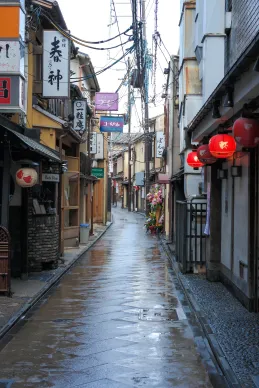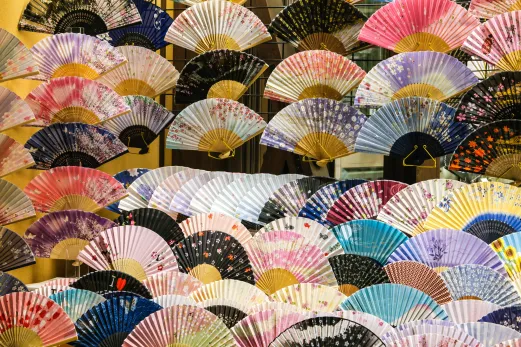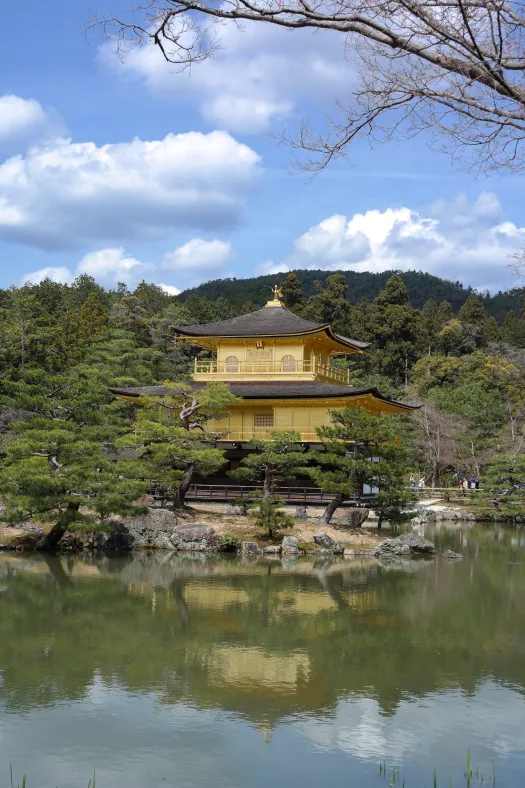
To say we all loved Kyoto would be an understatement. It’s a wondrous place, magical really! The history, the people, the food, the beauty… three days was definitely not enough. In true HilaryStyle I wanted to make the most of our time and we saw as many things as possible each day. We definitely needed that Shinkansen (bullet train) ride back to Tokyo just to get in a rest!
Our visit took place during the height of the cherry blossom season and finding accommodations even four months out was next to impossible! I highly recommend booking a room as soon as you know you’re going.



We stayed at the Kyoto Watazen Ryokan, which is a traditional style Japanese inn complete with tatami-matted rooms, communal baths, and in room meals. It is considered bad manners to enter the communal baths with any type of clothing on, so I was grateful our room had its own bathroom complete with tub, toilet and shower. Staying in the ryokan was quite a different experience and the kids really enjoyed it! When we arrived the room was made up like a little living room complete with table and cushions. Each evening while we were out and about our room would be transformed into a sleeping area with futons and blankets made up all in a row. We had a lot fun trying out the kimono style robes and other Japanese amenities provided.
The Kyoto Watazen Ryokan was a little bit tired, but the people were incredibly friendly and the service was perfect. It is located in an excellent area of Kyoto within walking distance to many sites!
Day One
Nishiki Market

Within walking distance from our ryokan was the lovely Nishiki market! A fabulous place filled with stall after stall of beautifully displayed food, spices, utensils and more. Though many of the things on display were a complete mystery to us we had a lot of fun and sampled quite a few of them. Octopus on a stick wasn’t on that list! All of us really enjoyed wandering through the market and it was definitely worth visiting!

Kiyomizu-dera

Kiyomizu-dera is a Buddhist temple which was built around 780. It is a UNESCO World Heritage site. Most of the year the temple is only open in the daytime, but because we were visiting during cherry blossom season there were special evening hours. The gardens are illuminated and the effect of the lights on the thousands of pink and white cherry tree blossoms is breathtakingly beautiful. The gardens are also lit in the autumn when the maple leaves begin to change. The main temple building is incredibly large and sits precariously suspended over the hillside on which it is perched. Incredibly the main hall and stage were built entirely without nails! There are lovely views of Kyoto in the distance. There are many buildings on the site and we were able to wander through the gardens and among the buildings, but due to our nighttime visit we weren’t able to go inside.

Day Two
Hiring A Guide
Deciding what to see in new places can be challenging and while we do make a general outline of what we might want to see I usually don’t like to reserve tickets or book tours ahead. We like the ability to change our minds if need be. However, I made an exception in Kyoto. Not only did we have a language barrier to contend with, but we also had very limited time in Kyoto. I wanted to make sure we didn’t miss anything worthwhile and at the same time we would get a general lay of the land. This made such a difference on day three when we were again on our own!
Booking in the high season meant that we had to hire the guide for a minimum of six hours, but they were great about working with me on an itinerary that was family friendly and met our family’s individual needs.
Our guide was an incredibly friendly man named Kenzo Sato. He is a native of the area and had been giving tours for seven years. We all really enjoyed his company and I think the feeling was mutual! The day before we set out I had compiled a list of places I definitely had to see while in Kyoto and many of them turned out to be on Kenzo’s list!
He not only planned our itinerary, but arranged transportation from place to place and took us to one of his favorite restaurants for lunch. Before we parted ways at the end of what was a fabulous day our guide was kind enough to go over my ideas for day three.
How did we find our guide? Lonely Planet! I was reading their Kyoto guide and I discovered that the author Chris Rowthorn operates an independent tour company! How perfect! The book is great, so the tour company will be too! And it was!
Fushimi Inari-Taisha
Fushimi Inari-Taisha is just one of around 80,000 Shinto shrines throughout Japan. Amazing! I am sure there are many beautiful ones. However, I doubt many people will disagree with my opinion that this one really stands out as something particularly special! It’s famous for the literally thousands of vermilion torii gates lining the pathways which lead you through the woods and to the top of Inari Mountain. There are many smaller shrines along the way and at the top. It takes about two hours to get to the top and while it is a steady climb it’s not terribly difficult and even Elliot had no trouble. Along the way there are a few places to stop and get a bite to eat or a drink.

Once you reach the top you can either go back the way you came or head down the backside of the mountain which is much quieter with less foot traffic. It is still very beautiful, but there aren’t as many torii gates. We walked through some natural bamboo forests and came out into a lovely residential neighborhood.
Ema

When visiting Shinto shrines you will find stands with little square plaques of wood or other shapes called ema. They are available for purchase. The idea is that you can write your wish on it and leave it there in the hopes that the deity of the shrine will grant your wish. All types of wishes are made. We purchased one, but instead of making a wish we had Kenzo write our names on it in Japanese and we brought it home to hang on our christmas tree.


Tofuku-ji Temple and Tofuku-ji Zen Garden

We were able to walk through residential neighborhoods on our way to visit the Tofukuji Temple. The gardens here were incredibly beautiful and a real contrast to the simple beauty of the grounds outside the walls. Each side of the building has a different type of garden. We didn’t spend much time here, but it is quite an impressive sight and definitely worth a look! I would love to come back here too see the autumn leaves which it is known for.
This Zen temple is the oldest and largest in Kyoto and the Sanmon gate, a national treasure, is the oldest Zen main gate in Japan.


Yasaka Pagoda
Located near Kiyomizu-dera the Yasaka Pagoda is all that’s left of the Hokanji Temple. It’s quite an impressive sight, but due to time constraints we weren’t able to go inside. It dates back to 589!
Chion-in Temple

The Chion-in Temple was under construction during our visit, so we were unable to go inside, but we were able to wander the temple grounds. The temple bell is gigantic weighing 79 tons! It is a Japanese custom to ring all the city’s bells 108 times at midnight on New Year’s Eve! This giant bell is no exception even though it takes an entire team of monks to ring it!
Shoren-in Temple

Shoren-in Temple located a short distance from Chion-in Temple was an incredibly tranquil and lovely place. The gardens were spectacular and if you have a chance they are open for nighttime viewing. If you make an offering you can ring the temple bell and with a little help from Kenzo, Elliot was happy to do so!
Gion District
The Gion District is a well-known Geisha district in Kyoto and I had read in my Lonely Planet guide that Shinbashi-dōri in Gion is the most beautiful street in all of Asia. I was determined to see it! I haven’t seen a lot of Asia, so I don’t have a lot to compare it with, but I can say it was definitely one of the most beautiful streets we saw while in Japan! In recent times traditional Japanese attire has become more popular with the younger generation so you do see a lot of people dressed in kimonos, seeing an actual Geisha is more rare as they don’t tend to just hang out on the street. We did “catch” sight of one on her way somewhere!
Day Three
Kinkaku-ji Temple of the Golden Pavilion

Kinkaku-ji temple is one of the most popular buildings in Japan and it absolutely deserves to be! Not only is it located in a stunningly beautiful setting, but the top two floors of the building are covered in gold leaf! Yep! The outer walls are entirely covered in gold! Due to its extreme popularity you should expect large crowds, but if you are patient you can get some pretty great photos!
Ginkaku-ji Temple of the Silver Pavilion

Ginkaku-ji was built by the grandson of the Shogun who owned Kinkaku-ji. It was give the name Silver Pavilion because it was eventually supposed to be covered in silver foil. This was never realized and the temple has remained “unfinished”. The gardens here are stunning with a variety of features including a sand garden, moss gardens and a wooded area.
The Philosophers Walk

The Philosophers Walk is a pedestrian path that follows a cherry-tree-lined canal in Kyoto it’s very close to Ginkaku-ji and other sights. It’s especially beautiful during the cherry blossom season. There are a number of worthwhile shops and restaurants nearby which we poked in and out of. I picked up a few neat little souvenirs to bring home.
Eating in Kyoto

We really enjoyed the food in Kyoto! I wish I could tell you which restaurants we liked best, but the truth is that we almost never knew the name of anywhere we ate. I will say that I can’t think of even one place where we didn’t enjoy the meal! Just take a chance!

